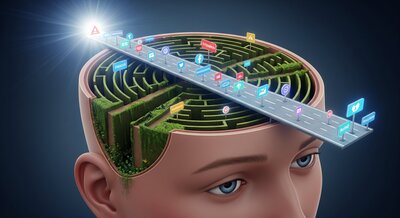It starts with a flicker.
A barely perceptible hesitation.
You're deep in a task—writing a report, debugging code, planning a project. You're in the zone, making progress. Then you hit it.
It's not a giant roadblock or a catastrophic failure.
It's a "snag."
Maybe it's a sentence that just won't land right. Maybe it's a piece of data you need but don't have at your fingertips. Maybe you've just finished one small task and haven't decided on the next one. It's a momentary wall, a small point of friction where the path forward is, for a split second, unclear.
And then, before you've even registered the snag, your fingers have a mind of their own. Ctrl+T. You're opening a new tab. You're on Twitter, Reddit, YouTube, or checking email for the fifth time in ten minutes.
The original task, and the snag that triggered this escape, sits waiting. You've just fallen into the autopilot trap.
This isn't a failure of willpower.
It's a failure of recognition.
We often focus on blocking the end-result—the distraction itself—without ever understanding the subtle cue that sends us there. To truly regain control, we need to perform an anatomy of that snag, to understand the triggers that push us from focused work into digital muscle memory.
The Brain's Default Setting: The Path of Least Resistance
Our brains are fundamentally efficiency machines. They are designed to conserve energy by creating shortcuts for common actions. When you brush your teeth or drive a familiar route, you don't consciously think through every single step; you run a pre-programmed script. This is your brain on autopilot, and it's incredibly useful.
The problem is, this same system creates a "path of least resistance" for our attention. Over years of digital conditioning, we have taught our brains that the easiest, quickest solution to any feeling of mental friction or boredom is a dopamine hit from a new tab.
Hitting a snag is a moment of friction. It requires cognitive effort to resolve. Your brain, in its quest for efficiency, sees this effort and immediately looks for the well-worn escape hatch. The snag is the cue, and the autopilot response—opening Twitter—is the routine. It's a habit loop running on a subconscious level. Until you learn to see the cue, you'll be trapped in the loop.
Dissecting the Snag: Three Common Triggers
While snags feel instantaneous, they usually fall into one of three categories. By learning to identify them, you can prepare for them.
1. The Cognitive Strain Snag
This is the most common type. It happens when your brain is working hard and hits a point of increased difficulty. It's the mental equivalent of a weightlifter struggling on their final rep.
- Examples: Trying to parse a complex paragraph, wrestling with a difficult math problem, figuring out why your code has a bug, or trying to phrase a tricky email.
- The Feeling: A sense of mental strain, frustration, or feeling "stuck."
- The Autopilot Response: "This is hard. I need a break." The "break" is almost always a slide into low-effort, high-reward distraction.
2. The Transitional Void Snag
This snag occurs not during a task, but in the empty space between tasks. You have momentum from finishing one thing, but that momentum dissipates the second you have to decide what to do next. This micro-moment of unstructured time is a vacuum that your brain rushes to fill.
- Examples: Immediately after sending an important email, after finishing a chapter of reading, completing a to-do list item, or right after a meeting ends.
- The Feeling: A brief sense of aimlessness, uncertainty, or "what now?"
- The Autopilot Response: "I've earned a little reward." You use the void as an excuse to check notifications or browse, turning a 10-second transition into a 15-minute detour.
3. The Emotional Discomfort Snag
Sometimes, the work itself triggers a negative emotion. The task might be boring, intimidating, or stir up feelings of inadequacy (imposter syndrome, anyone?). The snag isn't a lack of ability, but a lack of desire to feel that specific emotion.
- Examples: Opening a spreadsheet you find tedious, starting a project you feel unqualified for, or having to give critical feedback to a colleague.
- The Feeling: Boredom, anxiety, dread, or self-doubt.
- The Autopilot Response: "I don't want to feel this right now." You seek a different feeling—the fleeting amusement of a meme, the social validation of a 'like'—to numb the discomfort of the task at hand.
From Autopilot to Intentional Choice: Anticipating the Snags
You can't eliminate snags.
They are an inevitable part of any meaningful work. What you can change is your response. The goal is to insert a conscious choice into the space between the snag and the autopilot reaction.
Strategy 1: Name the Snag. The moment you feel that flicker of hesitation or frustration, give it a name. Silently say to yourself, "Ah, this is a Cognitive Strain snag," or "This is a Transitional Void." The simple act of naming it brings the subconscious cue into your conscious awareness. It creates a pause, and in that pause lies your power.
Strategy 2: Pre-plan Your Transitions. The Transitional Void is the easiest snag to anticipate. When you plan your workday, don't just list your tasks; decide exactly what you will do immediately after each one. Instead of "1. Finish Report, 2. Email Bob," make it "1. Finish Report, and the very next tab I open will be a new email to Bob." Remove the void, and you remove the trigger.
Strategy 3: The Five-Minute Rule. For Cognitive Strain and Emotional Discomfort, make a deal with yourself. You don't have to solve the whole problem, you just have to stay with it for five more minutes. Start a timer. This micro-commitment is usually enough to push through the initial friction. More often than not, you'll find your footing and keep going long after the five minutes are up.
Strategy 4: Have a Productive "Default". Your brain will always seek the path of least resistance. So, create a better one. Instead of letting Twitter be your default, choose a "productive distraction." When you hit a snag, your pre-planned autopilot could be to stand up and stretch, grab a glass of water, or simply look out the window for 60 seconds. It still gives your brain a micro-break but keeps you out of the digital vortex.
Ultimately, regaining your focus isn't about brute force. It's about developing a new sensitivity to your own mental state. It's about treating every snag not as a frustrating obstacle, but as a training opportunity—a chance to perform one more rep, to lay one more stone in the path, and to teach your brain that when things get just a little bit hard, you don't run away.
You gently, and deliberately, return.



